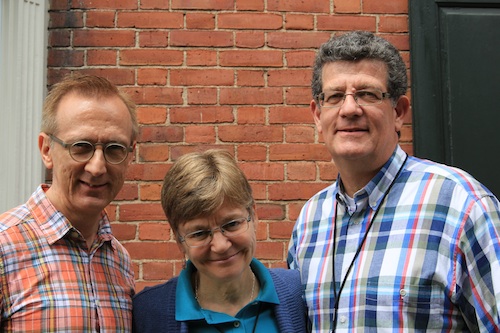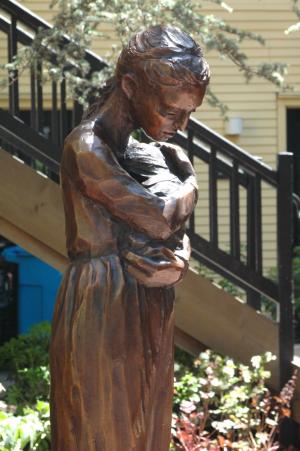
St. Mary’s Episcopal Church: A Magnificat Community
by Amanda Weber, M.M. ‘13
 What’s in a name? This is the question pervading St. Mary’s Episcopal Church in Arlington, Virginia, as the congregation seeks to embody more intentionally the voice and spirit of its namesake, the Virgin Mary. This congregation, which values worship, arts, children, and outreach, has begun to hear Mary’s song more clearly and in deeper relation to its mission. This call brought three church leaders from St. Mary’s to the ISM Congregations Project to engage in conversation with teams from six other churches around the country and several faculty members. This year’s theme, embodiment, could not have been a better fit for their project. As Mary literally embodied the living gospel in bearing Jesus Christ, this team asked how their congregation, which is specially related to her, might be united as one body and sent out to be God-bearers today.
What’s in a name? This is the question pervading St. Mary’s Episcopal Church in Arlington, Virginia, as the congregation seeks to embody more intentionally the voice and spirit of its namesake, the Virgin Mary. This congregation, which values worship, arts, children, and outreach, has begun to hear Mary’s song more clearly and in deeper relation to its mission. This call brought three church leaders from St. Mary’s to the ISM Congregations Project to engage in conversation with teams from six other churches around the country and several faculty members. This year’s theme, embodiment, could not have been a better fit for their project. As Mary literally embodied the living gospel in bearing Jesus Christ, this team asked how their congregation, which is specially related to her, might be united as one body and sent out to be God-bearers today.
While Mary’s role in the life and death of Jesus is undoubtedly profound, different denominations have paid more or less attention to her over the years. The Roman Catholic church’s veneration of Mary and observation of Marian festivals is well known. To the contrary, faculty member Bryan Spinks reported in a lecture on Marian devotion, for many years Anglicans almost forgot about Mary apart from her appearances in scripture. Against this backdrop, this congregation is exploring how to lift up Mary’s place in the gospel story and reclaim her as inspiration in the liturgy of life and of the church. Lay leader and resident artist Peggy Parker joyfully articulated that it is a blessing to be a church that bears Mary’s name. Mary is a part of the identity of the congregation, and St. Mary’s has the responsibility and delight of discovering how to live into their name.
The process of discovery has been and will be a continuous one, noted faculty member Rita Ferrone, who spoke about the concept of ongoing conversion. Christians experience conversion in many forms (theistic, Christic, ecclesial, moral, affective, intellectual), both as individuals and as communities. Though we most commonly think of conversion as happening at a singular point in time, we are more likely to experience different aspects of conversion over and over again as we continue turning to God in various ways over time. “God isn’t finished with us yet!” Rita announced. The process of embodying God as Mary did (theotokos) is just that – a process.
Fr. Andrew Merrow, rector of St. Mary’s, introduced the congregation by saying that worship is at the center of the congregation’s life; everything comes to and goes forth from the liturgy. The mission statement for the last thirty years has identified worship, children, and outreach as primary concerns. At the summer seminar, ideas about how each of these could be inspired by Mary flowed freely. Mary’s acceptance of God’s call provides an example towards which God’s community, the church, is called to strive. More specifically, Mary’s spontaneous song, the Magnificat, offers guidance for both children and adults as they respond to the call to serve the greater community. This radical text overflows with images of joy, humility, social justice, and lasting promise.
 Moreover, Mary’s Magnificat is a song—and thus a reminder of the importance of singing in the life of faith. Gregory Hooker, Minister of Music at St. Mary’s, is especially interested in the capacity of music to proclaim the gospel to youth. Might we interrupt the cycle that has many youth becoming inactive after confirmation by making choir a safe place for teenagers to explore issues of identity so they ultimately can find their voice in the church? How can we help parents to expand their vision of Jesus so that they see not only the baby in the cradle but also the adolescent teaching in the temple? Choirs, which create unity from a diversity of voices, have the potential to be contexts for ongoing conversion and settings in which young people become leaders of worship. “Singing in a choir is a microcosm of the body of Christ,” Gregory declared, and therefore a place for people of all ages to practice finding their voice—a place to discover the confidence and assuredness of Mary to sing out, even in uncertain times.
Moreover, Mary’s Magnificat is a song—and thus a reminder of the importance of singing in the life of faith. Gregory Hooker, Minister of Music at St. Mary’s, is especially interested in the capacity of music to proclaim the gospel to youth. Might we interrupt the cycle that has many youth becoming inactive after confirmation by making choir a safe place for teenagers to explore issues of identity so they ultimately can find their voice in the church? How can we help parents to expand their vision of Jesus so that they see not only the baby in the cradle but also the adolescent teaching in the temple? Choirs, which create unity from a diversity of voices, have the potential to be contexts for ongoing conversion and settings in which young people become leaders of worship. “Singing in a choir is a microcosm of the body of Christ,” Gregory declared, and therefore a place for people of all ages to practice finding their voice—a place to discover the confidence and assuredness of Mary to sing out, even in uncertain times.
In addition to the rich musical life at St. Mary’s, the congregation is blessed to have the artistic gifts of Peggy Parker, a remarkable sculptor and printmaker. Already, she has adorned St. Mary’s with two images of Mary – a sculpture of the young mother Mary, and a woodcut pietà showing an aged and sorrowful Mary, part of a set of the Stations of the Cross. These images have helped to draw the congregation in, as the arts so often do, giving visual representation to stories and emotions that are still very much alive in the world today. “What would it be like to call a whole congregation into a practice of intentional looking?” wonders Peggy. In what ways can visual art enliven and provoke a congregation to ongoing conversion?
In image, text, and song, Mary offers her namesake congregation in northern Virginia many forms of inspiration and insight – as a discerning teen, as a young mother, as a grieving parent. In what other ways might Mary inspire and lead the congregation of St. Mary’s over the years to come? In her remarks on ongoing conversion, Rita Ferrone commended the importance of looking back over a period of time to see the gradual change that has taken place. St. Mary’s has been enriched by the journey thus far. May they be blessed and emboldened as they follow Mary’s example into the future, unsure of what lies ahead.